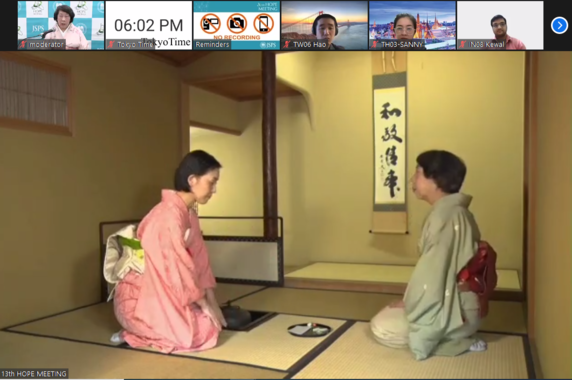HOPE Meetings with Nobel Laureates
13th HOPE Meeting
Report of the 13th HOPE Meeting
Date: Monday, 7 March through Friday, 11 March 2022
Meeting format: Online meeting via web conferencing system
Subject fields: Physics, Chemistry, Physiology/Medicine and Related Fields
Organizer: Japan Society for the Promotion of Science (JSPS)
Meeting format: Online meeting via web conferencing system
Subject fields: Physics, Chemistry, Physiology/Medicine and Related Fields
Organizer: Japan Society for the Promotion of Science (JSPS)

Participants waving goodbye to each other and Organizing Committee chair Prof. Kajita (top row, second from left) on the last day of the event
Participating in this HOPE Meeting were 91 doctoral students and young researchers from 21 countries and regions in the Asia-Pacific and Africa*.
*Participants-Nominating Countries/Regions
Japan, Australia, Bangladesh, China, Egypt, India, Israel, Kenya, Korea, Malaysia, Myanmar, Nepal, New Zealand, Philippines, Senegal, Singapore, South Africa, Taiwan, Thailand, Turkey, Vietnam
*Participants-Nominating Countries/Regions
Japan, Australia, Bangladesh, China, Egypt, India, Israel, Kenya, Korea, Malaysia, Myanmar, Nepal, New Zealand, Philippines, Senegal, Singapore, South Africa, Taiwan, Thailand, Turkey, Vietnam
For the first time, the 13th HOPE Meeting was held via an entirely online format, as the global impact of the novel coronavirus pandemic had still not subsided. Holding the meeting online required a synchronization of time differences between the Nobel Laureates living in Europe and North America and the young researchers participating from a wide range of regions across East Asia and Oceania to the Middle East and Africa.
Though unfortunately we were unable to meet face-to-face this time, there was a silver lining: nine Nobel Laureates participated, the largest number in the history of HOPE Meetings. They each gave 45-minute lectures including Q&A sessions in which the young researchers asked questions and engaged the Laureates in opinion exchanges.
Though unfortunately we were unable to meet face-to-face this time, there was a silver lining: nine Nobel Laureates participated, the largest number in the history of HOPE Meetings. They each gave 45-minute lectures including Q&A sessions in which the young researchers asked questions and engaged the Laureates in opinion exchanges.
Donna STRICKLAND
Nobel Laureate in Physics 2018
Barry C. BARISH
Nobel Laureate in Physics 2017
KAJITA Takaaki
Nobel Laureate in Physics 2015
YOSHINO Akira
Nobel Laureate in Chemistry 2019
Gregory WINTER
Nobel Laureate in Chemistry 2018
William E. MOERNER
Nobel Laureate in Chemistry 2014
Kurt WÜTHRICH
Nobel Laureate in Chemistry 2002
Randy W. SCHEKMAN
Nobel Laureate in Physiology or Medicine 2013
Tim HUNT
Nobel Laureate in Physiology or Medicine 2001

Lecture by Prof. Kajita

Lecture by Prof. Schekman
Another highlight of the meeting was the group discussions, each attended by one Laureate, one moderator and a small number of participants (20 or less) who gathered in virtual rooms. The sense of closeness that this format gave the members of the groups incentivized spirited exchanges between the participants and the Laureates. Young researchers who were not attending a group discussion could enter chat rooms and discuss various topics of common interest with their peers, including career paths, research funding, and work-life balance.

Group discussion conducted by Dr. Winter (in the yellow box)

| Group discussion conducted by Prof. Moerner (center) |
The participants were assigned two projects during the HOPE Meeting: an individual research presentation and a team presentation prepared and delivered with other participants.
Individual Presentations
The young researchers were given an opportunity to deliver poster presentations on their own research. An abstract of each presenter’s research along with a one-minute video in which they introduced themselves and described their research was posted in advance on the meeting's website, enabling other participants to view them at their leisure. During the meeting itself, virtual small rooms were set up for the participants to present their posters and entertain questions from their peers. Afterwards, a panel review based on a vote by the participants was held by the Organizing Committee to select the best presentations. The "Best Poster Award" was given to the six participants who delivered the most excellent poster presentations. Then, the Organizing Committee chair's award, the “HOPE Award,” was presented to one of the Best Poster Award winners.

Poster presentations by participant

| Poster award winners (Six in focus) |
Team Presentations
Team presentations gave the participants an opportunity to work in close collaboration with their peers during the HOPE Meeting. Within the meeting’s limited timeframe, teams of about 10 members who had never met each other before and who had different cultural backgrounds and research fields worked together in a virtual space to create presentations on how, as scientists, they could contribute to solving common issues such meeting sustainable development goals (SDGs) or tackling new global pandemics. At the meeting’s closing ceremony, two teams were, based on the results of a vote by all participants, presented awards, “Unique Team Presentation Award” and “Best Team Presentation Award,” by Organizing Committee chair Prof. KAJITA Takaaki.

Team C (Unique Team Presentation Award)

Team I (Best Team Presentation Award)
Research Institution Guide and Japanese Culture Experience Program
To offer the young researchers participating in the HOPE Meeting from other countries a window into the best of Japanese research, they were guided online through the research facilities of two of Japan's premier research institutions, the National Institute of Advanced Industrial Science and Technology (AIST) and the RIKEN. JSPS staff also gave the participants an introduction to the “JSPS Postdoctoral Fellowships for Research in Japan” program, describing pathways for overseas researchers to pursue their research in Japan.
The meeting also delivered a 45-minute program on experiencing Japanese culture. In it, the young researchers participated in a virtual tea ceremony, did origami (paper folding), and listened to a concert performed with traditional Japanese musical instruments. After having participated earnestly in the lecture and discussion sessions, the young researchers appeared to enjoy this change of pace—a relaxing time allotted for them to deepen their understanding of a different culture through hands-on folding of origami and giving ear to the colorful sounds of Japanese instrumentation.
The meeting also delivered a 45-minute program on experiencing Japanese culture. In it, the young researchers participated in a virtual tea ceremony, did origami (paper folding), and listened to a concert performed with traditional Japanese musical instruments. After having participated earnestly in the lecture and discussion sessions, the young researchers appeared to enjoy this change of pace—a relaxing time allotted for them to deepen their understanding of a different culture through hands-on folding of origami and giving ear to the colorful sounds of Japanese instrumentation.

Virtual tea ceremony

Concert performed with traditional Japanese musical instruments
